The “French Line” S.S. Île de France -
Part Two
Use Google Chrome for this Web Page to load perfectly!
Please Note: All ssMaritime and other related maritime
sites are 100% non-commercial and privately owned, thus ssmaritime is NOT
associated with any shipping company or any other organisation! Although the
author has worked and been involved in the passenger shipping industry for well
over 60 years, but due to his old age and poor health, he was forced to retire.
Yet, he has completed well over 1,435 Classic Liners, Passenger-Cargo Liners as
well as humble converted C3 converted Migrant Liners, which has transported
countless thousands folk to the new world, as well on vacations’. I trust
the features online will continue to provide Classic Liner and Ship enthusiasts
both the information they are seeking, but more so provide a great deal of
pleasure and relive many happy memories!
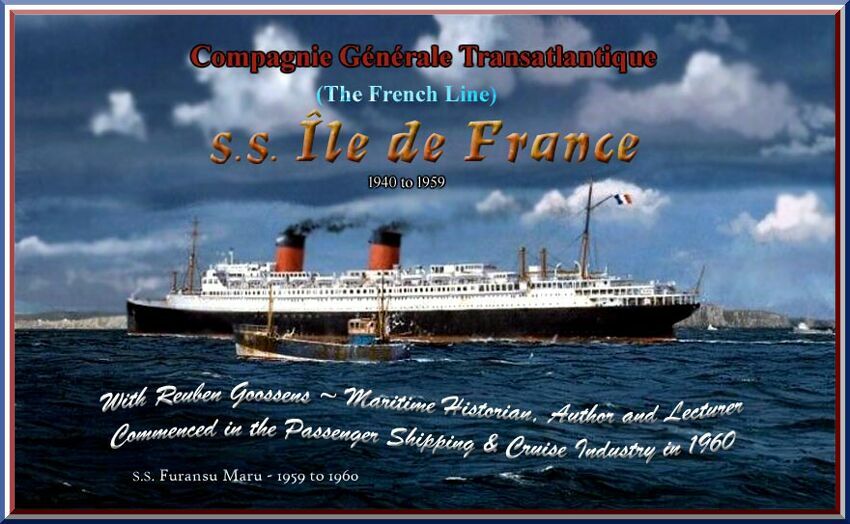
S.S. Île de France is seen after her post war refit with two funnels instead of her original three
Please
Note: Postcards, photographs & other images
are either from the author’s private collection or from my supporters.
Thus a very special thank you to three very special ssmaritime supporters for sending me their wonderful
photographs & images
I am sorry but some of the images shown may not be of the highest quality, but they are the best that were available
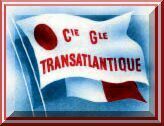
The official logo
of “Compagnie Générale Transatlantique” also known as the
“French Line”
Page Two
A Brief Introduction:
If you have arrived at this S.S. Île de France, you may need to read her early history first and view photographs of her public venues in all of her three Classes as well as her specifications and details and several links to Video’s of her.
You may either enter Page One Here or use the link to Page One at the bottom of this page.
World War Two:
Three “French Line” ships sailed on and proved they could continue to be a huge success, but sadly this was not to last, for two events would arrive and conclude the French Line’s ships of luxury and style as well as forthcoming losses.
The first event happened on April 18, 1939,
when the magnificent and palatial S.S.
The S.S. Île de France was the very last
civilian ship to leave
Having berthed at her
“Île de France” was moved and was then laid up at Pier 88, and on the other side of the pier (to her portside) was the French Line’s newest flagship; the 1935 completed liner of 83,423 GRT, S.S. Normandie, and berthed at the next two piers were two Cunard liners; the 80,774 GRT, “Queen Mary” of 1936, and the 45,647 GRT, “Aquitania” of 1914, as well as the Italian line’s 51,063 GRT, “Rex” of 1932.
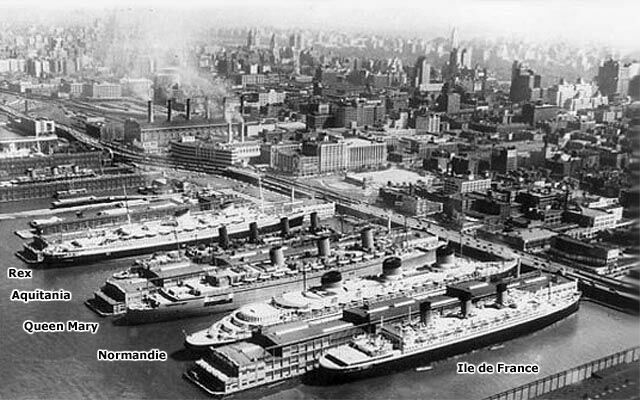
Having been at her berth for a short time,
“Île de France” was towed to
Requisitioned by the British Admiralty:
In March 1940, the “Île de France”
was officially requisitioned by the British Admiralty, for the French Line had
loaned the ship to
Sadly when
Some of her peacetime interiors were removed to make room to accommodate 9,706 berths for troops who would now be crammed into her once magnificent Art Deco cabins, while all the designer vases and statues throughout her vast interior spaces were removed, and holds that would not be used for hammock berths, was loaded with 12,000 tons of war materials and she would also transport, tanks, ammunitions, including shells, submarine oil, and several unassembled bombers that were stowed up on the aft open decks.
H.M.T. Île de
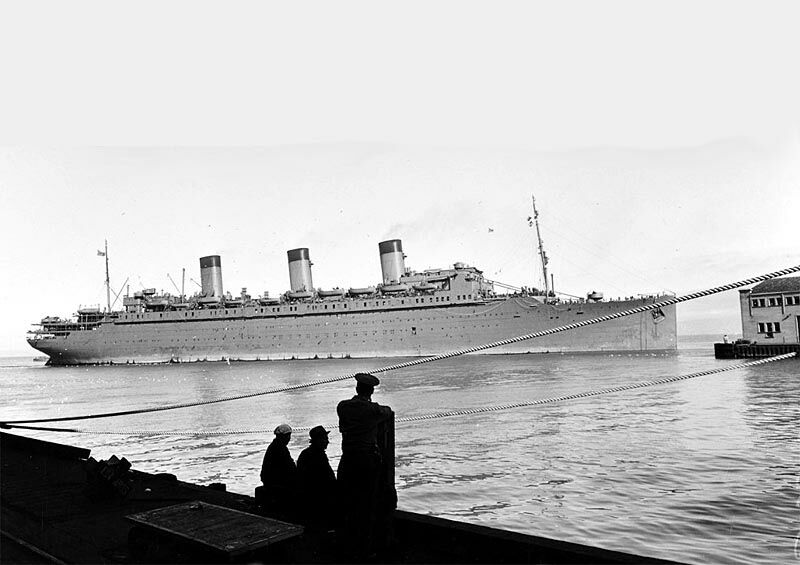
Here we see the just completed Troopship H.M.T. Île de France
Note the gun placement on her foc’sle and one high up aft of Sun Deck
Trooping Voyages:
Bill Munson Service No: WX232 a member of the
“Australian Imperial Force” serving in the ‘Signals
Core’ boarded the “Île De France” at an Australian port in
1941 and he and his regiment were transported to the
Later in 1941 she returned to
The 2/14th Infantry Battalion
boarded the “Ile de France” in
Boarding details for the above: She sailed
from Kantara, Egypt on January 30, 1942,
arriving at Bombay soldiers disembarked on February 6, all troops were
transferred on February 9, to the following ships; S.S.
Kosciusko, S.S. Madras City or S.S. City of Paris and they
headed for Adelaide, Australia arriving on March 23, 1942.
During one of her visits to the city she was
subjected to one of the worst events to befall this magnificent liner, for her
luxurious furniture, chandeliers, carpets and her finest fittings, thus all the
evidence of her former super Deluxe fittings, as well as hundreds of square
feet of fine rare timbers and marble panelling, were ruthlessly torn out and
flung on the quayside where much of it was destroyed. This woeful event was
described by
Then a small party of workmen came on board
and fitted out (the once luxury
liner) as a floating Prisoner of War Camp, there were
festoons of barbed wire sprouting from her decks, disfiguring her once graceful
lines. The “Île de France” had been prepared and commenced to
transport German POW’s from
On October, 1942, “Île de
France” was escorted by aircraft of the South African Air Force back
to
Operation Pamphlet:
Convoy Pamphlet was a World War
II convoy operation conducted during January and February 1943 to
transport the 9th Australian Division home to
The 9th Division was assembled
near
The convoy involved five transports, which
were protected from Japanese warships by a number of
Allied naval task forces during the voyage across the
The operation came after the British and
After their return to

“Île de
France” and
(taken during Operation Pamphlet in 1943)
From 1943 until she would be decommissioned in 1945, she had mostly a French crew, but she now was under the management of the Cunard Line.
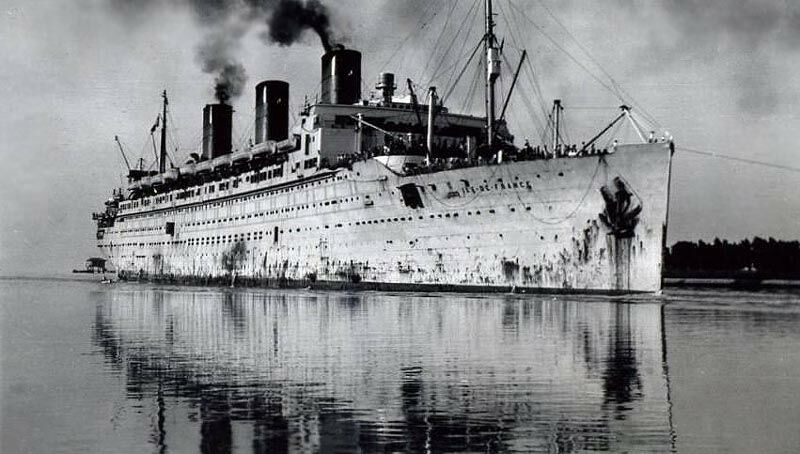
H.M.T. Île de
Another trooping voyage departed on February
14, 1944 from
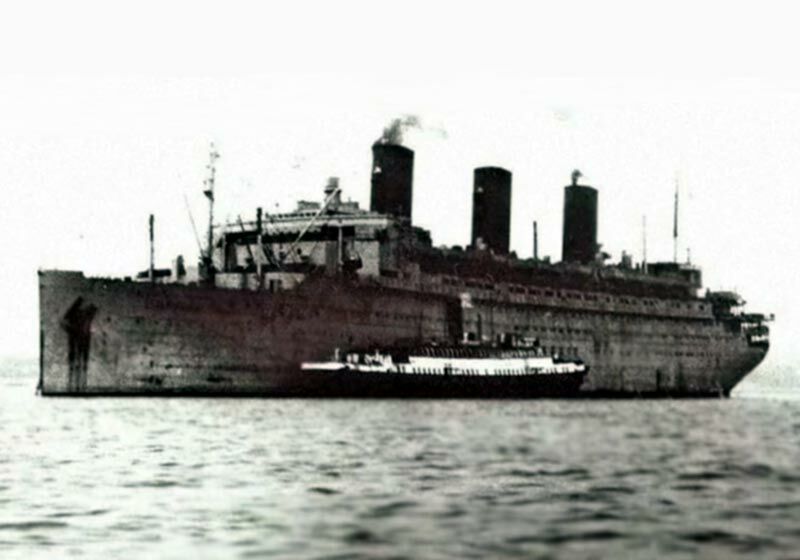
H.M.T. Île de France is seen toward the end of the war and after a hectic career as a troopship
Post War Service:
In 1945, with the war ended, the S.S. Île
de
Restoring “Île de France”
In April 1947 the “French Line” decided to send her back to her builders at Saint Nazaire as she required a massive overhaul and refit that would take around two years. The most noticeable change was in her exterior appearance; for her the middle dummy funnel was removed and she became a two funnelled liner.
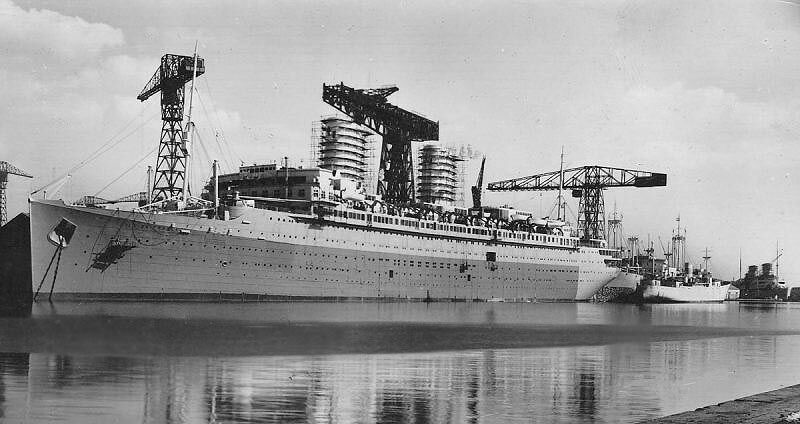
She is seen here during her refit with her new funnels being installed
Another external change was that her hull would now sport the livery that was inspired by the S.S. Normandie, with the black hull colour sweeping up to meet the forepeak.
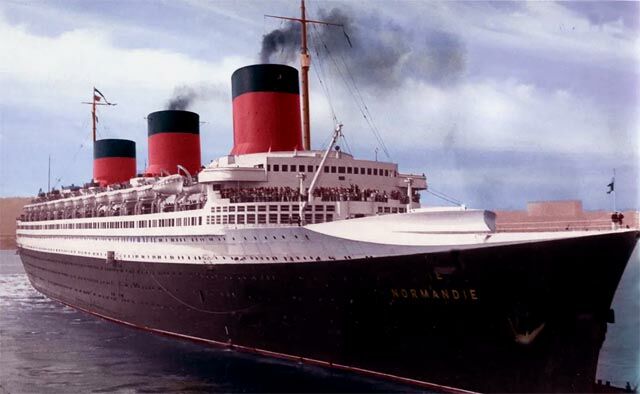
The great S.S. Normandie - 1935 until fire destroyed her in 1942
Note the bow as the black hull sweeps up to the fore-point of her bow
Her original public venues needed to be
redesigned and modernized and to assist
this, thankfully some interior parts which survived the tragic fire of
the “Normandie” in 1942 found a new home on
the “Île de France” making her when finished a very different
ship to what she had been. In addition her cabin configuration was also altered
and upon completion she able to accommodate a total of 1,345 passengers, made
up as; 541 First Class, 577 Cabin Class and 227 Tourist Class.
*********************
First Class Interiors:
As we have learnt, whilst she was under British control during the war her interiors were almost completely destroyed when she was being converted. Her magnificent timber and marble panels were smashed, thus when she was being restored into a liner, most was brand new, with just a few items remaining of her earlier days. Her designers did work hard to ensure that much of her furniture was much the same as it used to be, thus she did retain her elegance and sheer luxury!
Below are just some of her new public venues in First Class and an occasional one in what was now known as Cabin Class (ex Second Class).
Main Foyer & Stairwell:
The Area has received a new look, although the stairs are basically the same, but its look has completely changed with an arch in the centre and new fancy metal balustrades.
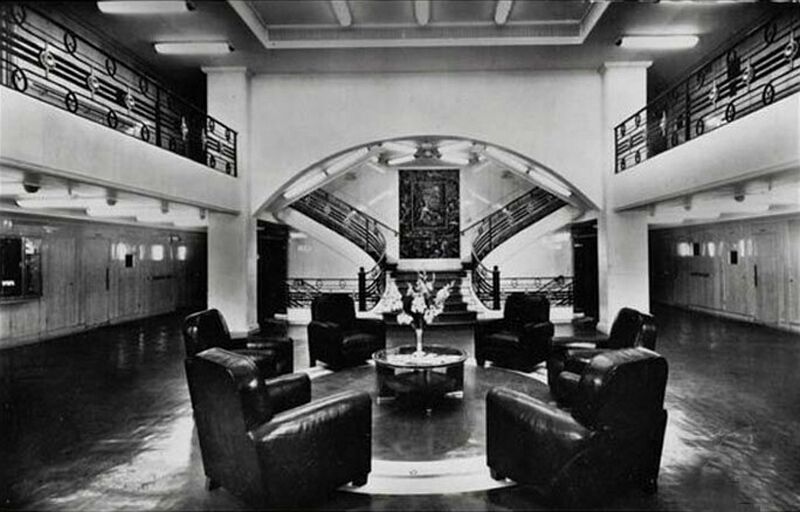
Above & below: Two views of the updated Main
Foyer and Grand Stairwell
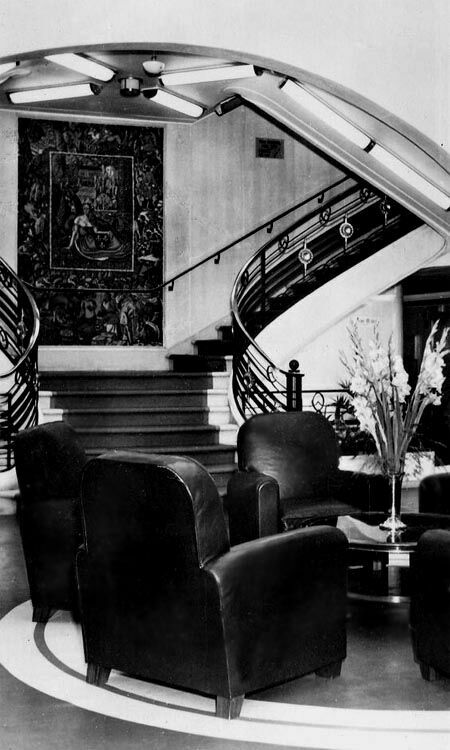
Grand Salon:
This venue certainly looks nothing like it did originally, but it was refurbished and became more modern looking, and a fine Lounge.
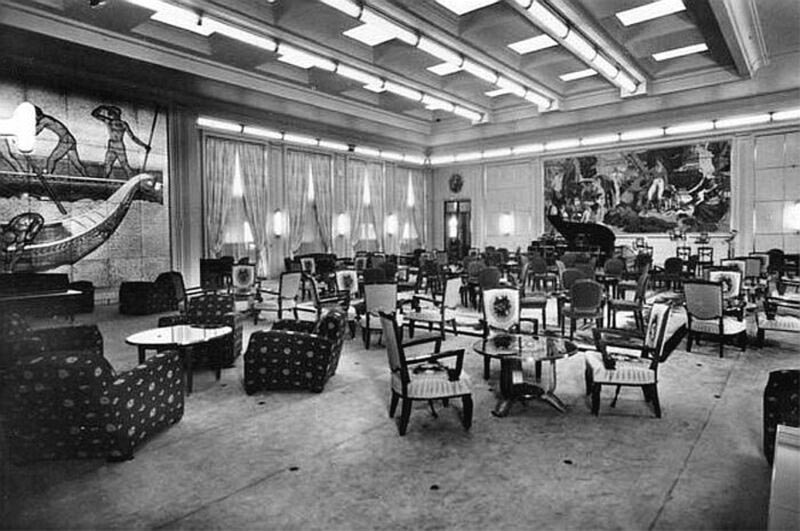
Above & below: The new look Grand Salon as
well as a colourised version below
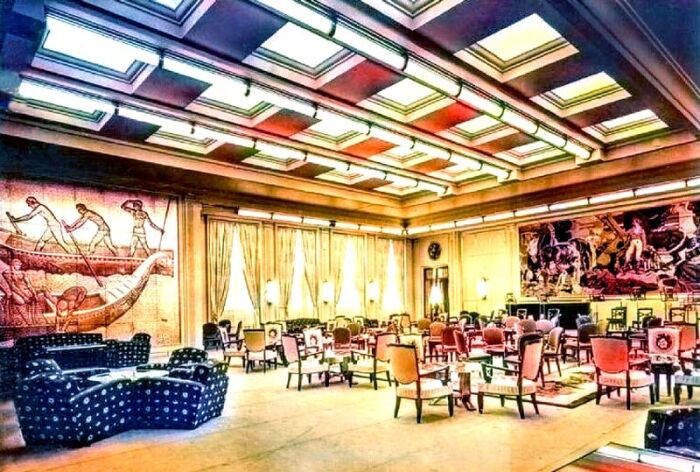
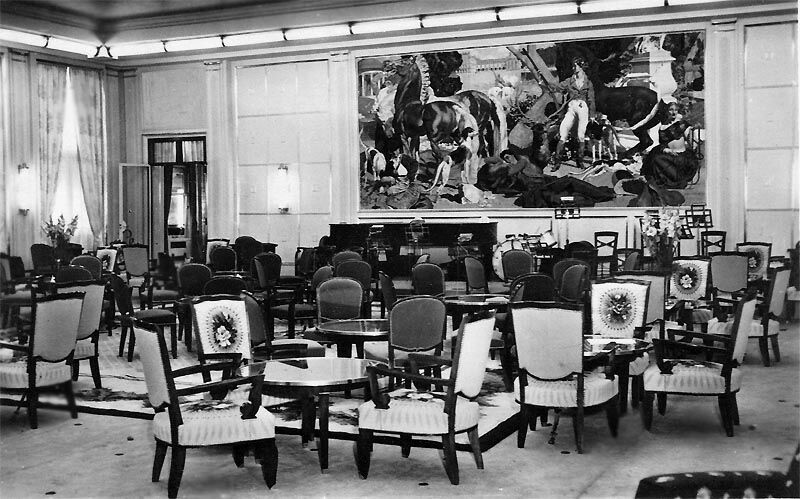
Another view of the Grand Salon
The Smoking Room:
This venue was relocated and it certainly had an imposing look; near one wall in front of a mirror stood a life sized sculpture which survived from her pre war days. The mirror reflected an amazing copper feature wall opposite.
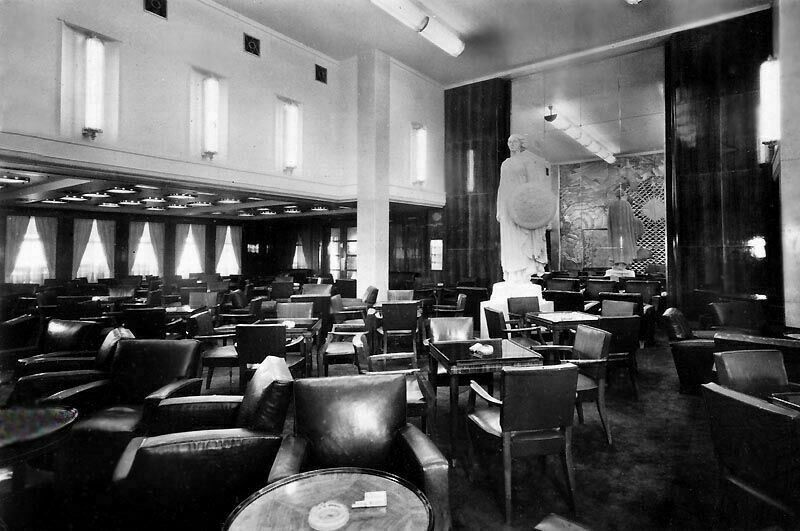
Above & below: Two views of the huge Smoking
Room
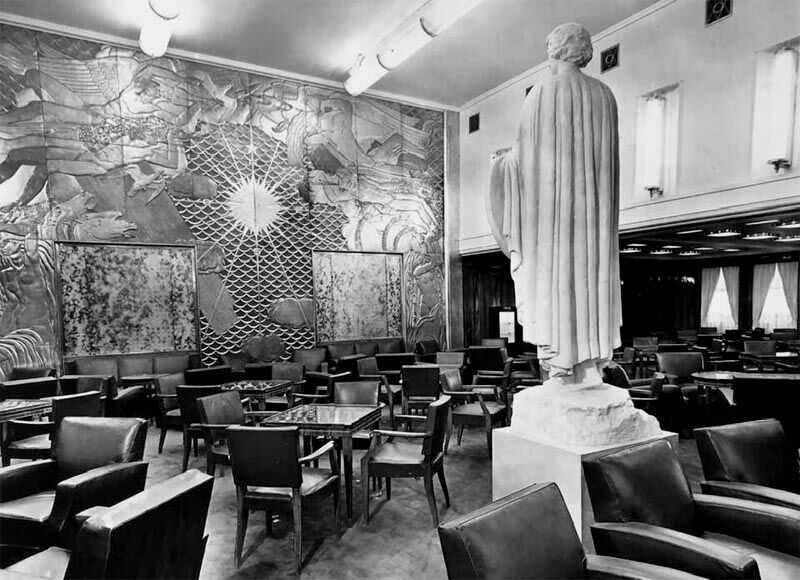
Dining Room:
The Dining Room was very similar to her previous version, but changes saw new large drop light fittings and the stairway received an update, still with marble columns, but new metal balustrades.
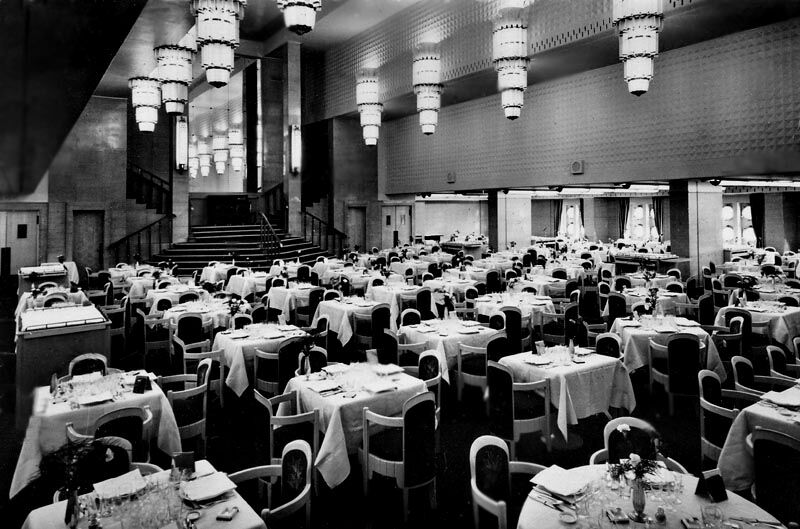
Above & below: The Dining Room in its new
post war look
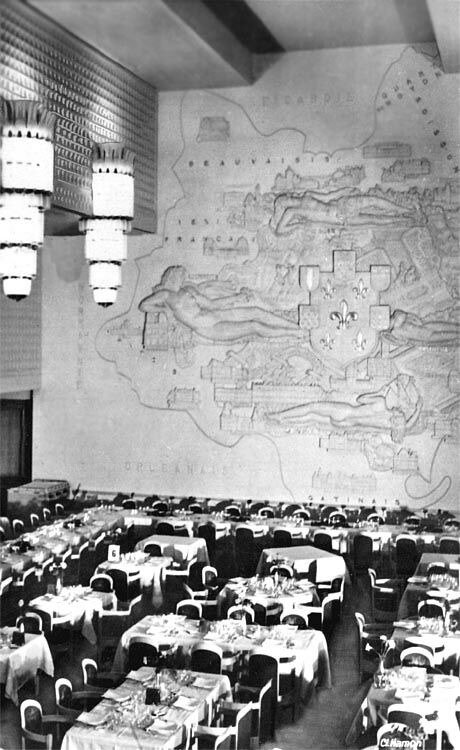
Library & Writing Room:
This used to be known as the Long Gallery, but there was a door in the middle separating the two venues, the Library was forward on the portside and the Writing Room aft.
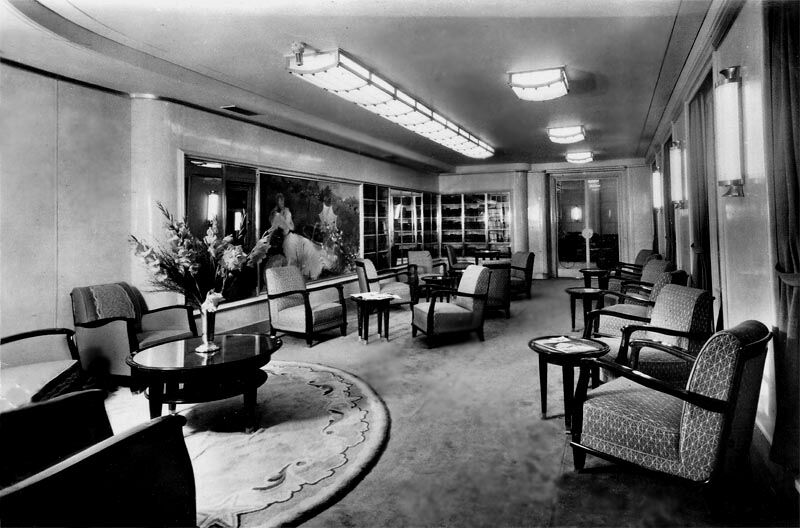
Above & below: The Library and reading area
and the Writing Room
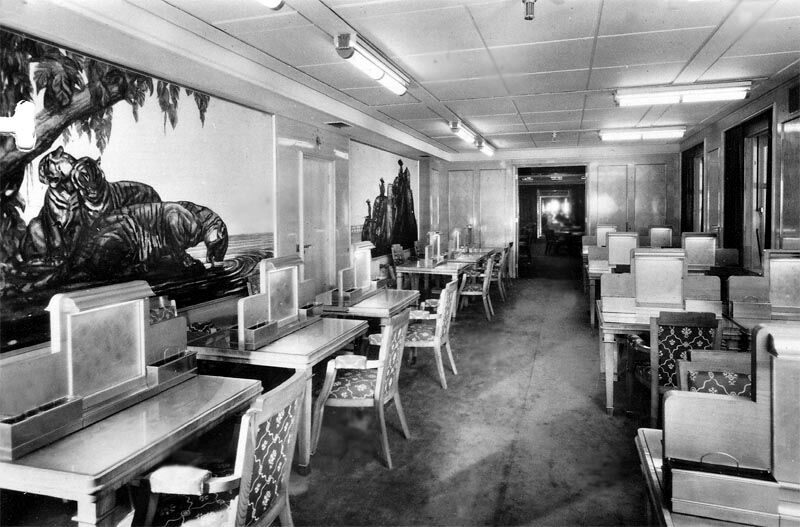
Gym and the Children’s Playroom:
The Gym was greatly updated with new ways to exercise, including padded mats on the floor and machinery as well as many other items to make one fit. The Playroom received a huge makeover looking more like a fun place for the children and there was also a “Punch & Judy” theatre.
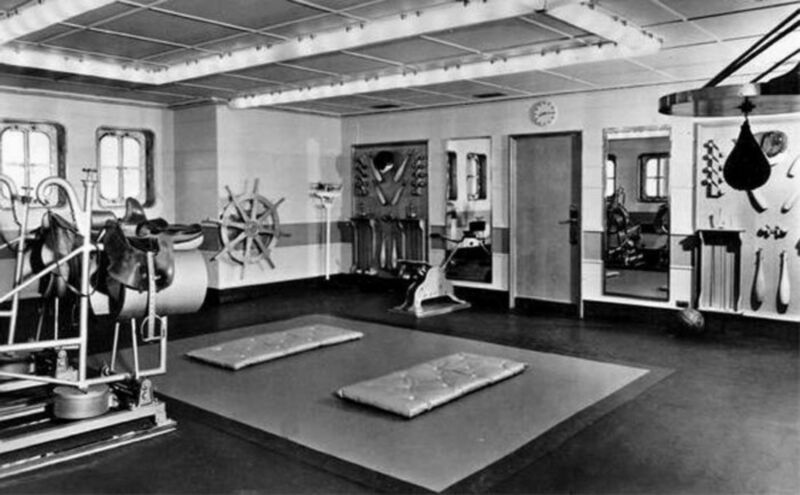
The new and
updated Gym
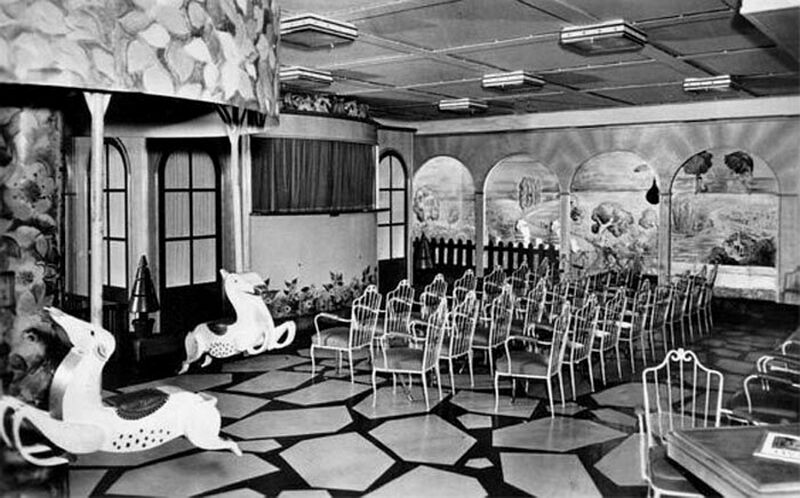
A magnificent Playroom
Accommodations:
The new look Deluxe Suites were of a high standard as before, but very much with a new more comfortable style look.
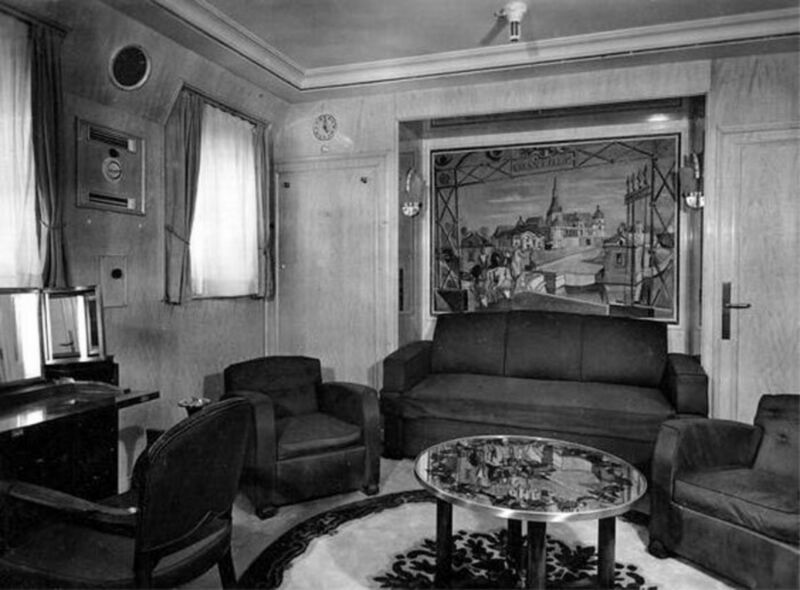
Above & below: One of the Grand Suites
showing the Lounge and bedroom
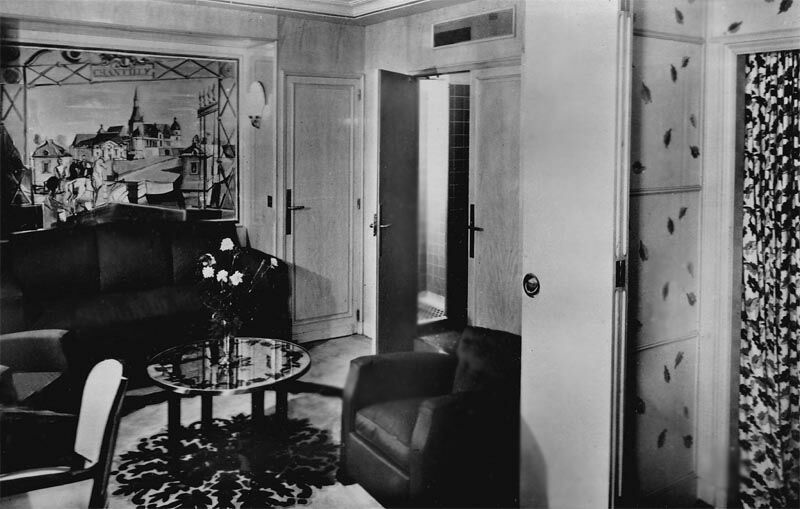
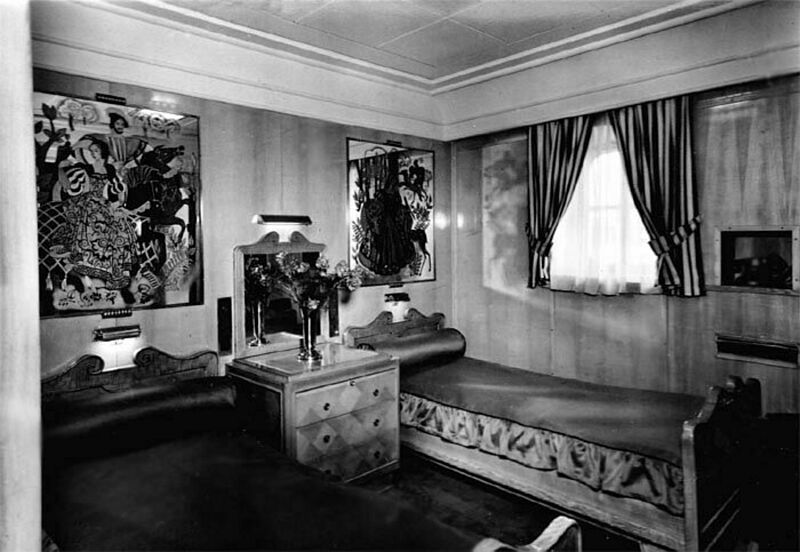
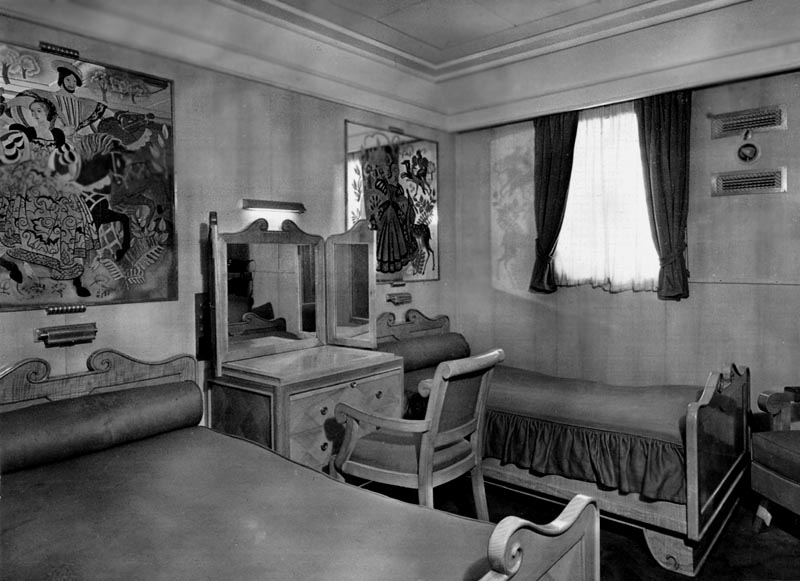
Here we see a
suite’s bedroom with air-conditioning fitted
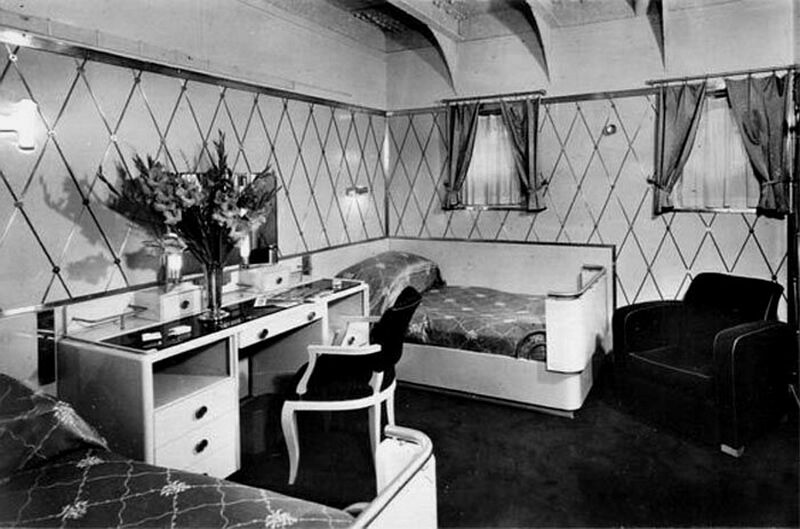
Here we see what is called the “Parlor Suite”
Cabin Class:
The Main Salon:
This two level venue’s décor was just beautiful, the main large feature on the lower level was a massive mirror that had been painted in a classical style and it was stunning, good enough to be seen on any first class Deluxe liner! The floor was covered with fine patterned carpet and with the stylish furnishings and the chandeliers combined with the curved staircase to the upper level made this room simply stunning!
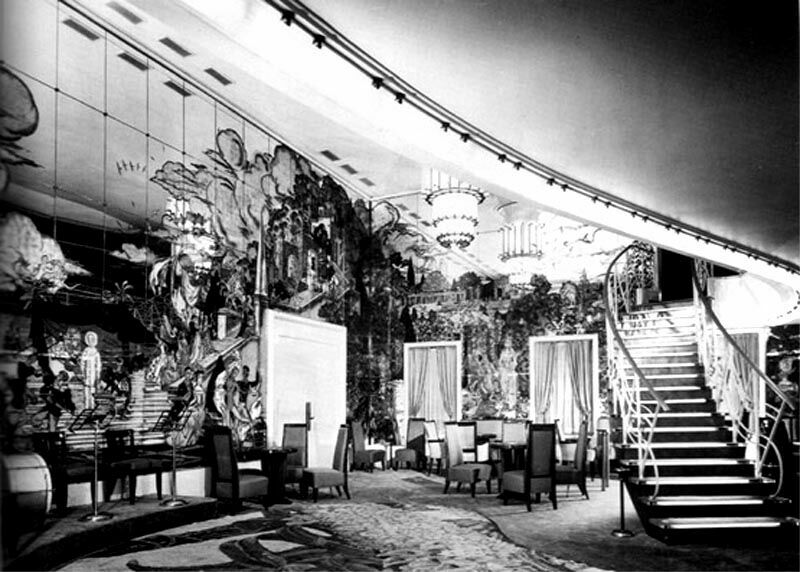
The new Salon was
certainly very impressive
Above & below:
Two angles of Cabin Class’ Main Salon
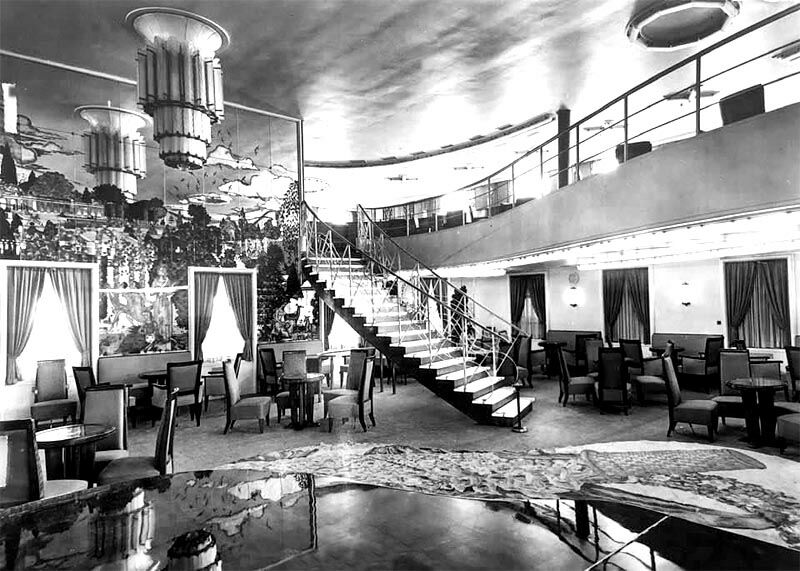
Dining Room:
The Dining Room was bright and a very pleasant venue to dine with its new look.
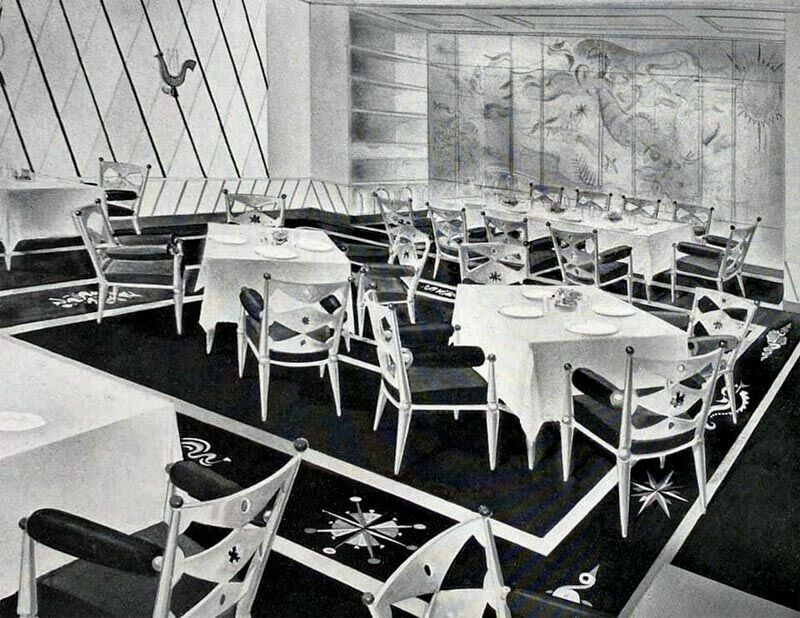
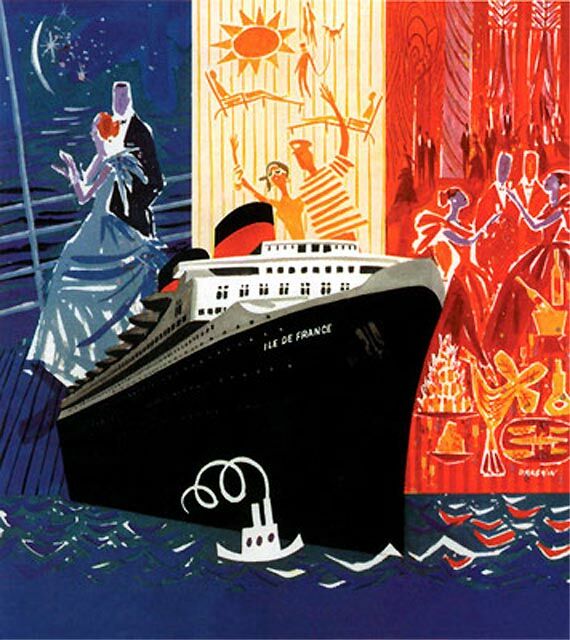
An advanced poster of the refitted S.S. Île de France
*********************
Île de France
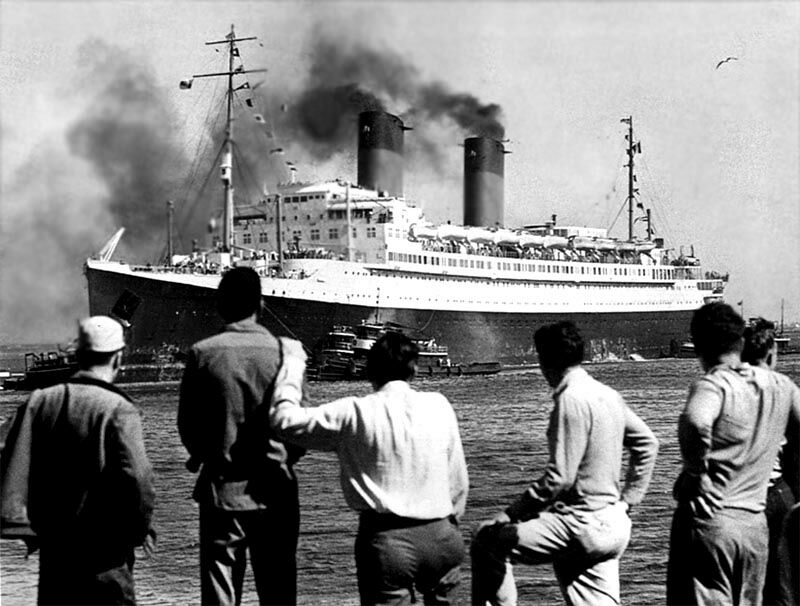
The new look S.S.
Île de France departs
It has been almost ten years since the “Île de France” had carried passengers from Le Havre to New York, and having now been fully rebuilt and refitted she was ready to resume her career as a liner.
Thus on July 21, 1949 the “Île de
France” resumed her original service from
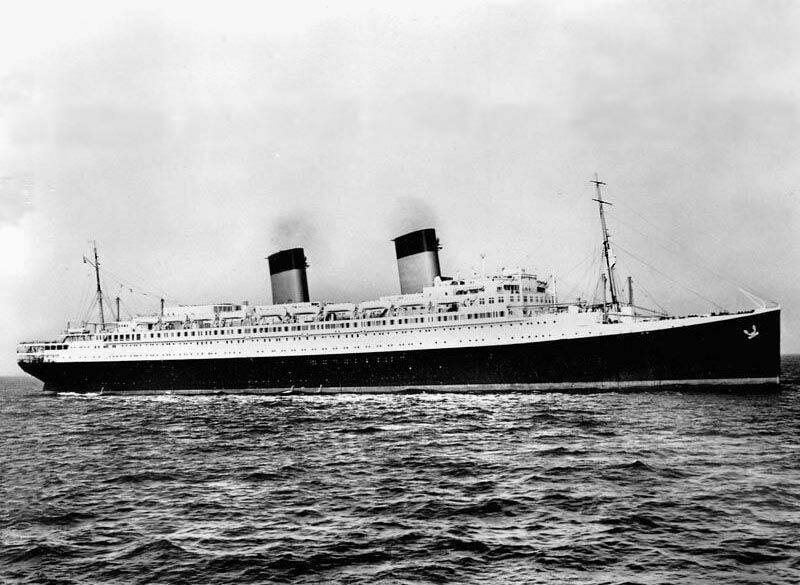
This great liner
still looked elegant with her two funnel configuration
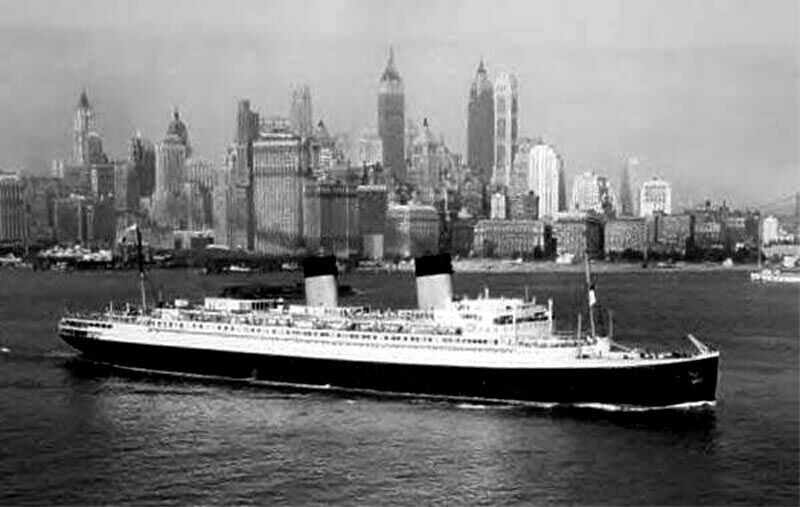
S.S. Île de France
seen departing
She sailed on with countless happy passengers in all her three classes, thus she kept busy in addition there were thoughts of her operating some cruises in the off season and her Trans-Atlantic voyages for the rest of the year.
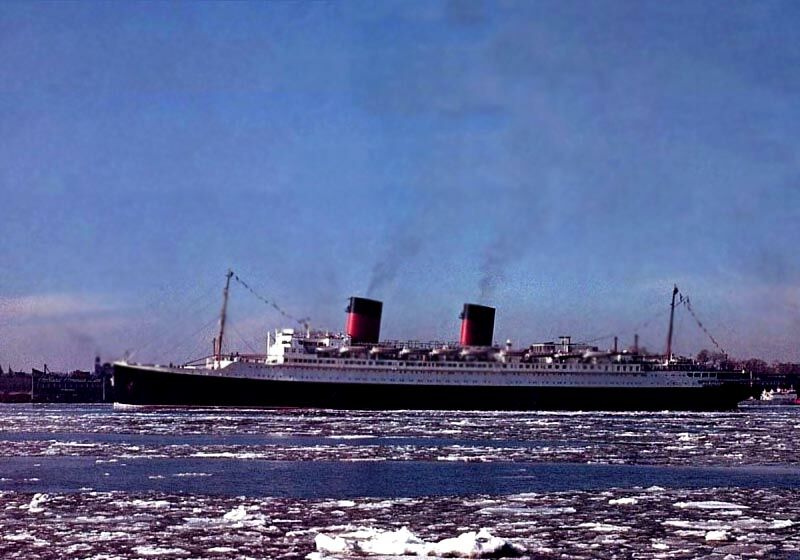
“Île de
She did have some adventures, as in the 1950’s she came to the aid of two ships which sank and the crew of the “Île de France” conducted rescues from a Freighter as well as a luxurious Italian Liner.
Rescue of the S.S. Greenville
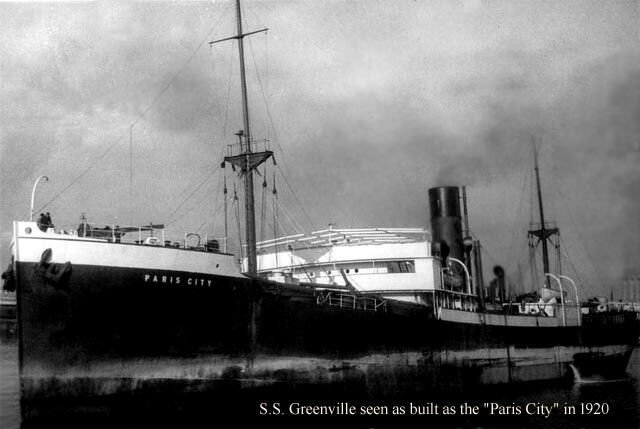
“Île de France” as of recently was also operating Caribbean Cruises during the off season, and they filled so quickly as travellers booked well in advance and she was booked out almost within a week after the brochure was released.

The 1953-54 Cruise
brochure cover
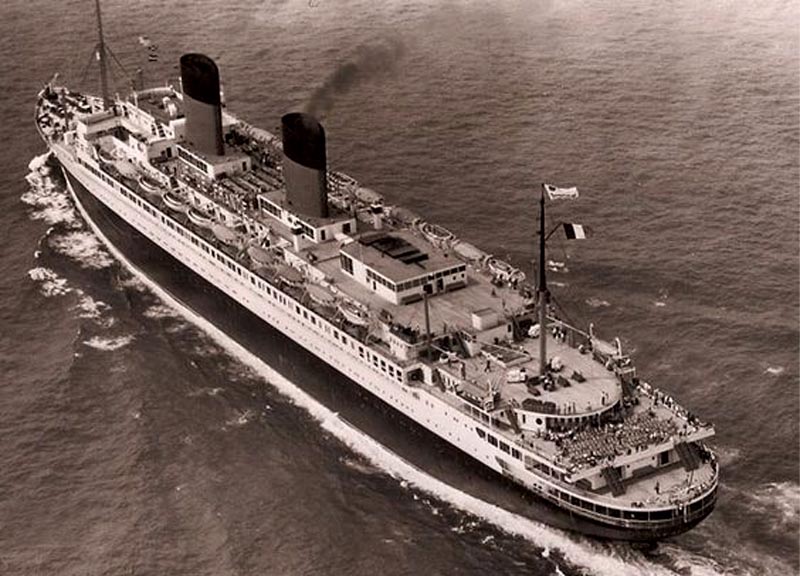
A fine aerial view of “Île de France” seen as a cruise ship
Cruise Souvenirs:
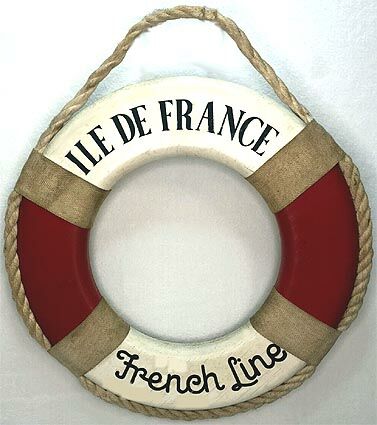
This miniature Wooden “Île de France” Life Ring was purchased in the Gift Shop
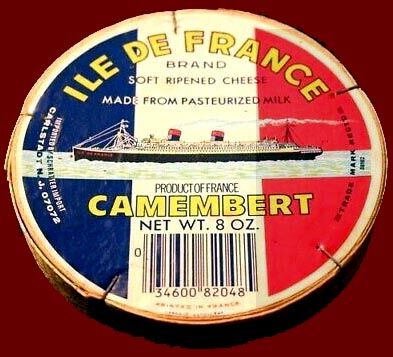
And for the American’s they could take home a genuine “Île-de-France” Camembert Cheese
The Sinking of the liner
S.S. Andrea Doria in 1956:
On July 25, 1956, as the S.S. Andrea
Doria was approaching the coast of Nantucket,
The “Andrea Doria” tragically sank the following morning, but of the 1,706 passengers and crew on board her 750 people were rescued and taken on board the “Île de France” during a six-hour rescue operation on July 25, and the “Île” became the only foreign ship ever to have won the “United States Gallant Ship Award” being a title reserved for ships “participating in outstanding or gallant action in a marine disaster or other emergency to save life or property at sea”. The “Andrea Doria” having capsized to starboard but on the morning of July 26, 1956 she quickly sank.
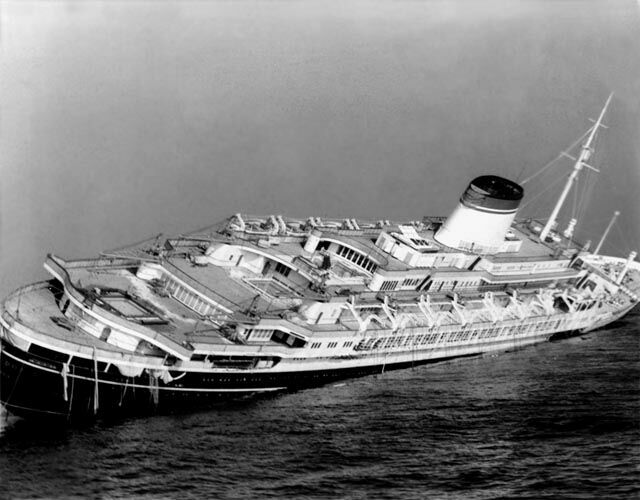
The “Andrea
Doria” is seen lying on her starboard side on the morning of the 26th
and will soon sink
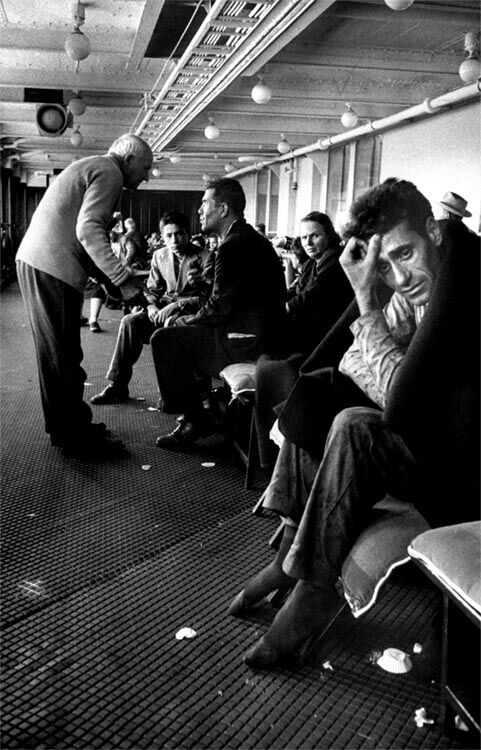
Passengers from
the “Andrea Doria” are seen on “Île de France’s”
Promenade Deck
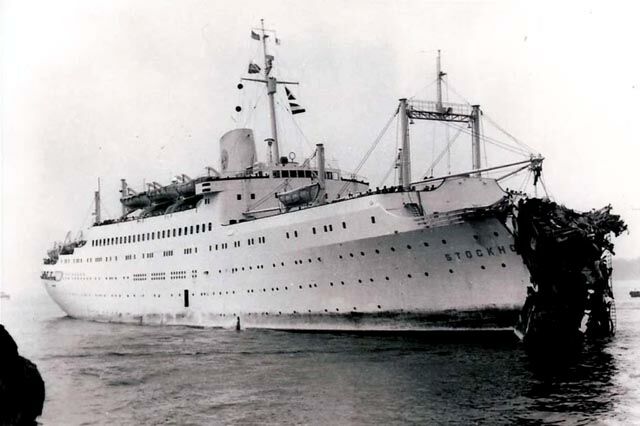
M.S. Stockholm seen on the scene with her bow sheered off
The
Back to her Liner Services:
In 1956 the “Île de France” had
been a passenger liner and a Troopship during WW2 for a good 29 long years, yet
she had always been an exceptionally popular ship. Thus she continued to please
her guests with the very best of French hospitality, fine food and good music
as well as the latest movies in her Cinema.
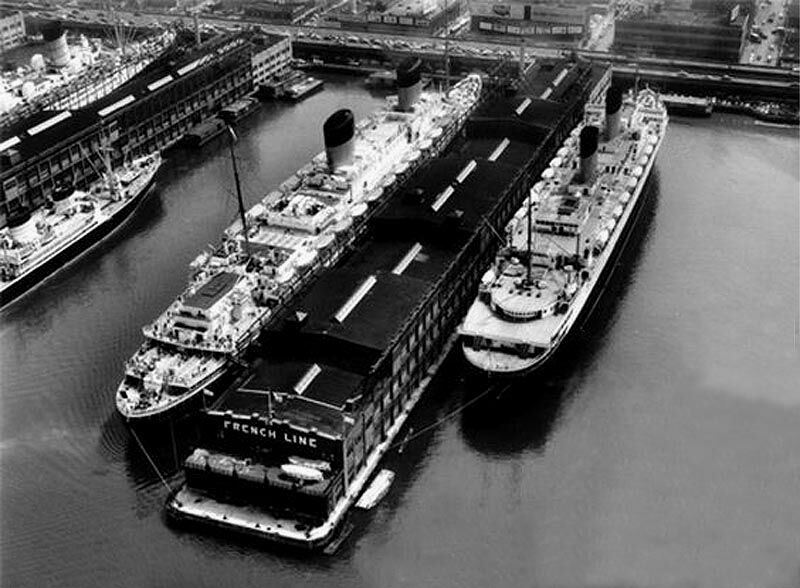
The “Île de
France” is seen at
the other side of the berth is the 1930 completed S.S. Liberté, built
as the German liner “Europa”
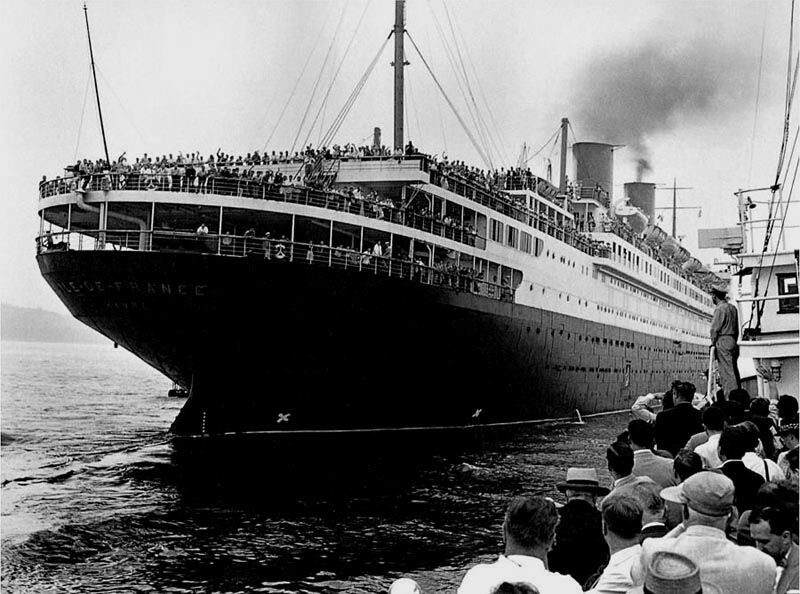
A great stern view
But the truth was that within just several years everything in the Passenger Shipping Industry would change dramatically, and it will also affect one of the most popular Trans-Atlantic liners ever.
Dramatic Changing Times for Ocean Travel:
S.S. Île de France continued her
Trans-Atlantic services as per usual up to 1958. However, by the autumn of that
year there was no doubt that her old age was catching up with her, having been
at sea for a good thirty-one years. But it was also true that sadly there were
less and less passengers booking passage for it had slowed down dramatically
over the past twelve months, being mostly due to air travel across the
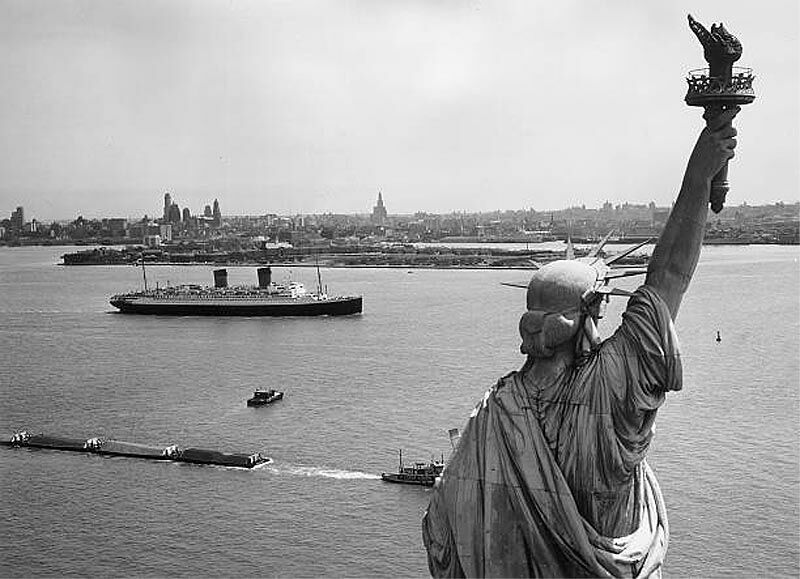
On November 10,
1958 she started her final voyage from
Thus the “French Line” decided to
sell the great liner and they quietly sold her on February 16, 1959
to “Yamamoto & Co” ship-breakers of
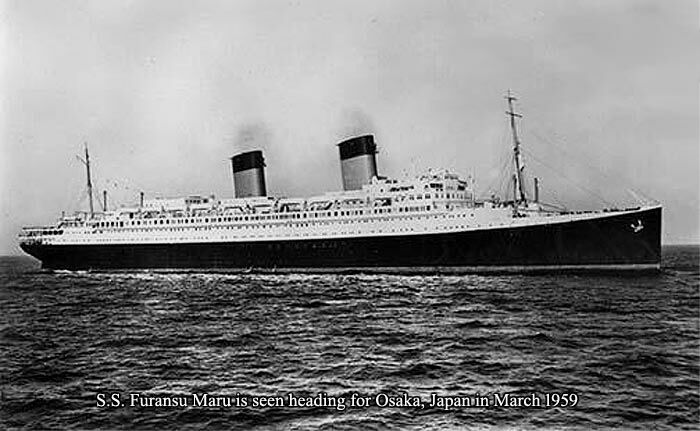
She is seen
heading for
However, just before going to the breakers yard she was leased out for US$4,000 per day to “Metro-Goldwyn-Mayer” who would use her as a ship named the S.S. Claridon for their maritime disaster movie named “The Last Voyage”. The film starred: Robert Stack, Dorothy Malone, George Sanders and Edmond O'Brien with many more.
During the making of the movie, some of her interiors were destroyed by explosives and she was also partially sunk and her forward funnel was pulled over in order for it to crash down on top of the bridge. All this was done in the name of “special effects.”
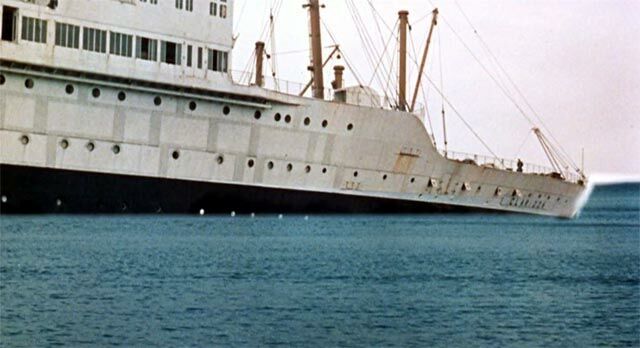
Above & below: the “Île de
France” is seen as the sinking cruise ship S.S. Claridon
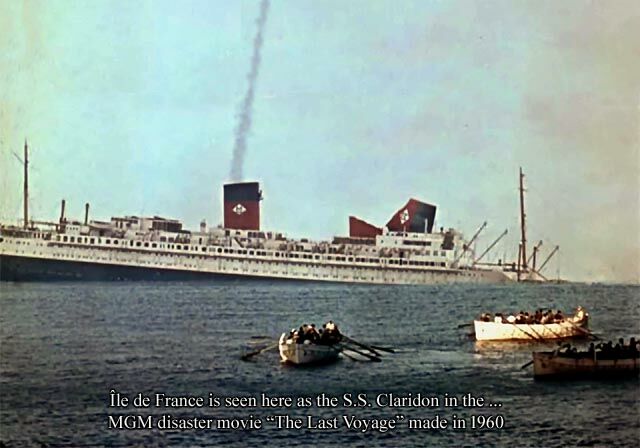
For what had been one of the Great Passenger
Liners loved by so many, it was a very sad and an undignified ending for such a
proud, beautiful Ocean Liner.

One of the official poster’s
After the shooting of the Movie, she was
refloated and she was then towed to her final destination, the breakers yard in
But about that movie - well it was regarded as being “A Flop” and thus it was even more of a very and an undignified ending to such a great and a proud, French Ocean Liner.
*********************
Remembering the Great …
S.S. Île
de France
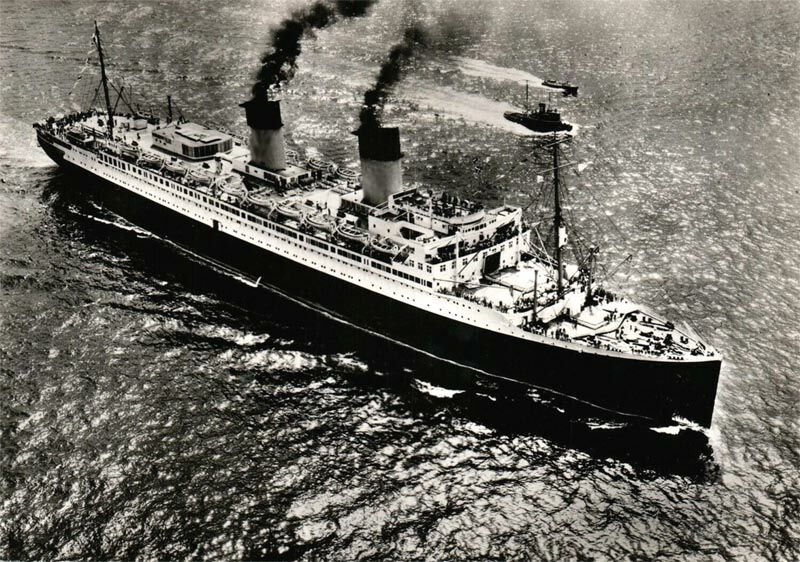
A magnificent view
of the remarkable
Return to Page One
View a 16.40 minute video of the great S.S. Île de France
Also visit the 3 page S.S. Normandie Feature - 1935 to 1947
And the S.S. Paris
- 1921 to 1947
**************
“Blue Water Liners sailing to the distant shores.
I watched them come, I watched
them go and I watched them die.”
Featuring over 1,435 Classic Passenger Liners, Passenger-Cargo Liners & Classic Cruise Ships!
Or ENTER HERE
For interest: Sadly an email service to ssMaritime is no
longer available, due to the author’s old age and chronic illness as well
as being disabled, etc. In the past ssMaritime received well over 120 emails
per day, but
*********************
ssMaritime.com & ssMaritime.net
The Author has been in Passenger Shipping & the Cruise Industry for well over 60 years
In addition he was the founder of “Save the Classic Liners Campaign” in 1990.
Please Note: ssmaritime and associated sites are 100% non-commercial and the
author seeks no funding or favours of any
shape or form, never have and never will!
Photographs on ssmaritime and associate pages are by; the author or from the author’s private collection. In
addition there are some images that have been provided by Shipping Companies
and private photographers or collectors. Credit is given to all contributors.
However, there are some photographs provided to me without details regarding
the photographer/owner concerned.
This notice covers all pages; although, and I have done my best to ensure that all photographs
are duly credited and that this notice is displaced on each page, that is, when
a page is updated!
ssMaritime is owned
& © Copyright by

